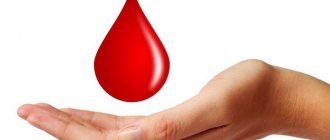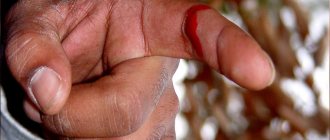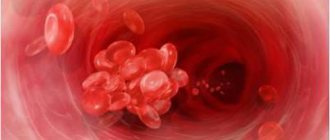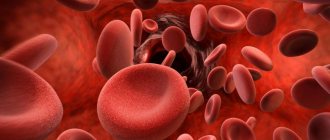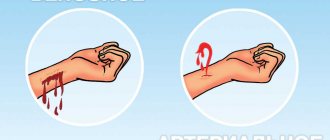Poor general blood test
A general (clinical) blood test is most often prescribed to patients.
Deviations of its values from the norm may indicate the development of diseases and pathologies in the body. Let's look at the main blood characteristics, changes in which indicate a poor general blood test.
1. Hemoglobin is a special blood protein that is responsible for transporting oxygen from the lungs to organs and tissues. A decrease in its level in the blood is very often the cause of poor blood tests during pregnancy. This deviation of the hemoglobin indicator from the norm indicates the development of anemia, which can lead to oxygen starvation of the expectant mother’s body. This is fraught with such serious consequences as delayed fetal development and premature birth. An increased concentration of hemoglobin in the blood occurs with congenital heart disease, blood thickening, intestinal obstruction, and erythrocytosis.
2.Red blood cells are red blood cells that carry oxygen in the body. Erythropenia (decreased red blood cell concentration) indicates iron deficiency anemia and blood loss. Erythrocytosis (increased red blood cell content) is a sign of dehydration, intestinal infections, pathologies of the lungs and hematopoietic system, heart disease, kidney and liver cancer.
3. Hematocrit - the ratio of the concentration of red blood cells in the body to the total volume of blood plasma. A decrease in its value may be the cause of a poor general blood test. In this case, it indicates anemia or overhydration. An increase in hematocrit occurs with dehydration of the body, congenital heart defects, erythremia, respiratory failure, and polycystic kidney disease.
4.Platelets are blood platelets that take part in the formation of blood clots. A decrease in their number indicates genetic diseases (May-Hegglin anomaly, Fanconi syndrome), megaloblastic anemia, adenoviruses, hepatitis, and malignant tumors. An increase in platelet levels is observed in myelofibrosis, erythremia, lymphogranulomatosis, lymphoma, liver cirrhosis, amyloidosis, rheumatoid arthritis, tuberculosis, and rheumatic fever.
5. Leukocytes are white blood cells responsible for the body's immune defense. Very often, a bad blood test occurs as a result of changes in this parameter. A decrease in the concentration of leukocytes indicates various pathologies and diseases (systemic lupus erythematosus, viral hepatitis, rubella, typhoid fever, malaria, brucellosis, influenza, measles, tuberculosis, malignant neoplasms). A high content of these cells in the blood accompanies leukemia, heart attack, otitis media, meningitis, bronchitis, and pneumonia.
6. Lymphocytes are a type of leukocyte that takes part in protecting the body from bacteria and viruses. A decrease in their level in the blood may be a sign of pneumonia, myocardial infarction, sepsis, or lymphoma. And their high concentration occurs in thyrotoxicosis and ARVI. In children, a high content of lymphocytes manifests itself in diseases such as mumps, chicken pox, scarlet fever, whooping cough, rubella, and measles.
7. Monocytes are immature blood cells, which, when they enter the human body, turn into macrophages (cells that destroy foreign particles, pathogens, dead cells). Decreased monocyte counts may be associated with anemia or hairy cell leukemia. And an increase in their concentration often indicates endocarditis, leukemia, lymphoma, tuberculosis, and sepsis.
8.Erythrocyte sedimentation rate (ESR) is an indicator that reflects the concentration of plasma proteins. When ESR increases, doctors talk about a bad blood test. A decrease in this indicator is observed in the case of overhydration and muscular dystrophy. One way or another, only a specialist can explain to the patient why the blood test is bad. Sometimes you need to donate blood again for testing.
Food for thought
Some facts about the disease:
The disease affects only men. This is not entirely true. There have been cases when the disease was diagnosed in representatives of the fair sex. There is an opinion that hemophilia is rarely diagnosed in women due to the physiological characteristics of the body. If a girl has poor blood clotting, menstrual bleeding can cause death.
- If a woman has the hemophilia gene, the child will be sick. In fact, women cannot plan for the birth of a sick or healthy child. This is only possible with artificial insemination and after special procedures. It is possible to determine whether a child has hemophilia or not only in the second month of pregnancy.
- Hemophilia and AIDS. In the 80s in the United States, after the advent of AIDS, it became clear that the pathology occurs not only among drug addicts or homosexuals, but also among those suffering from hemophilia. The virus was found in drugs used. It contained the blood of sick donors. A scandal broke out and pharmaceutical companies began producing safe, heat-treated medicine. But they didn’t take him outside the states. Residents of other countries continued to be sold spoiled drugs, as companies did not want to destroy drugs that were produced in large quantities. This would bring big losses. Therefore, the number of AIDS patients has increased.
Hemophilia is a serious disease, but you can live with it. There are even special organizations that unite people with this problem. In them, patients support each other and engage in various activities
It is important to remember: only by following the recommendations of specialists can you live a long life even with blood clotting disorders
Obviousness
Girls can only be carriers; only men can get sick.
Malfunctions in the functioning of the most important system of the body - the hemostasis system, designed to protect a person from blood loss - manifest themselves as a blood clotting disorder, that is, a pathology of coagulation of protein components of the blood in the event of bleeding.
The ability of blood to clot can be reduced for various reasons, leading to severe and fatal coagulopathies.
Prevention
In order to prevent bleeding after tooth extraction, competent actions must be taken by the dentist and the patient himself. Before surgery, the doctor needs to identify possible risks of the patient developing a problem. If the patient has a tendency to develop hypertension, then after the intervention several stitches are placed on the area of damage to the gums.
The patient, for his part, must also adhere to preventive recommendations:
- stop eating solid and rough foods in the first days after the intervention;
- do not take hot baths;
- stop taking Aspirin and other medications that thin the blood;
- exclude increased physical activity;
- monitor blood pressure readings and take special medications if they deviate from the norm.
We invite you to familiarize yourself with How to get rid of toothache: traditional medicine recipes and medications
Bleeding gums after tooth extraction is normal. But it should not be celebrated for too long. After eliminating the affected unit, the symptom is normally observed up to 24 hours and up to 3 days after wisdom tooth extraction. A slight discharge of ichor after surgery is allowed. You can cope with minor bleeding at home using gauze swabs, applying cold compresses to the sore side and traditional medicine.
How long does it take to bleed after a tooth is pulled out? Normally, the symptom disappears 30 minutes after the intervention. Blood discharge can be observed for a longer period of time if the patient does not comply with preventive rules. The main cause of the complication is usually infection of the socket due to damage or untimely formation of a blood clot in it.
How to treat
Treatment of poor clotting is a long process. A full examination is required, on the basis of which the doctor prescribes a course of treatment. Most often, treatment measures include:
Elimination of vitamin K and calcium deficiency. Elimination of disorders associated with the functioning of platelets in the patient’s body. Donor blood transfusion. The use of medications for the normal functioning of fibrinogen. Eating foods high in vitamin K, calcium, and amino acids. First of all, these are dairy products (cottage cheese, kefir, sour cream, cheese, etc.)
It is important to focus on eating leafy vegetables (spinach, green onions, white cabbage), meat, and fish.
After consulting with a doctor, you can turn to traditional medicine. Doctors recommend drinking decoctions of nettle, yarrow, and pine nut shells. Black currant leaves, arnica, and barberry fruits will also help.
As a result, bleeding disorders are a serious problem. In each specific case, a complete and comprehensive examination gives a clear picture of the disease. Based on this, the doctor draws up a course of treatment.
Blood is the life-supporting internal environment of the body. It performs many functions: delivery of oxygen and nutrients; removal of decomposition products; regulation of heat exchange; transport of active enzymes and hormonal substances; protective function in the form of phagocytosis and hemostasis. But what to do if it’s bad, what could be the consequences and causes of such a pathology.
In a severe form of disorder of the coagulation system - von Willebrand disease, characteristic subcutaneous hemorrhages are formed, hemorrhages into the periarticular bursa are frequent, and internal bleeding is possible. Von Willebrand disease is inherited, but there are also acquired forms. They often occur as a complication and can be provoked by rheumatoid diseases and some heart pathologies.
Poor blood clotting - what is it? Everything about hypertension
Have you been struggling with HYPERTENSION for many years without success?
Head of the Institute: “You will be amazed at how easy it is to cure hypertension by taking it every day...
Read more "
Poor blood clotting is a consequence of the development of internal diseases. If left untreated, it can lead to serious complications. Why? Because it is this process that determines how quickly the bleeding will stop.
If everything is in order with the body, the bleeding stops quite quickly. This usually takes a few minutes. A bleeding disorder can lead to large blood loss, hemorrhage into the cavity of internal organs or under the skin.
Why do disorders appear (and blood clotting especially)? What to do in this situation?
Diagnosis and symptoms
You can find out whether blood clotting is bad or good if you donate blood for a biochemical analysis. It is called a coagulogram.
Symptoms of poor blood clotting can be diagnosed using other methods:
- assessment of the ability of platelets to stick together;
- analysis of bleeding duration.
Seeing a doctor is necessary after symptoms of low blood clotting appear:
- Small or, conversely, extensive hematomas appear on the skin. They are usually caused by internal hemorrhages.
- Nosebleeds.
- Frequent bleeding in the mucous membranes of the mouth and nasal cavity, as well as the intestines. In the latter case, blood may appear in the stool.
- Brain hemorrhages.
- In case of injury, such as cuts, it takes longer than usual for the blood to stop bleeding.
- Hemorrhages began to occur in muscles, joints and even internal organs. This condition manifests itself in bruises that appear even with slight pressure on the skin.
If you notice at least one of the above symptoms, you should immediately consult a doctor. Ignoring such violations can lead to serious consequences, including joint pain, bleeding in the gastrointestinal tract and in the brain.
What are INR and PTI and how to control them
PTI is the prothrombin index, it shows how well the blood clots. In a healthy person it should be in the range of 70-100, and for adequate protection against stroke while taking warfarin it should be 24.0-42.6.
If the PTI is less, there is a risk of bleeding, and if it is more, the risk of stroke increases. There are many different methods for determining this indicator: according to Quick, according to Tugolukov, so if you donate blood in different laboratories, the results will vary greatly.
But sometimes the fate of the patient depends on this difference.
Therefore, PTI is not used abroad at all, since there is another more stable indicator of the INR - the international normalization ratio. The results of this analysis will not differ much in whichever laboratory in whichever country in the world you perform it.
The target INR level should be 2-3; if it is less, then prevention will not be effective; if it is more, then the risk of serious bleeding will exceed the benefit of prevented strokes. Hundreds of thousands of people around the world have taken part in studies to clarify this middle ground.
For each patient, the dose of warfarin should be selected individually, preferably in a hospital setting. For this, 7-10 days are usually enough. Then the analysis is done after 2 weeks, if everything is in order - again after a month, and then once every three months.
If the indicators are outside the target level, then a dose adjustment is made. You can learn to do this on your own, but it is always safer to consult a doctor after the next INR analysis.
In addition, for the accuracy of the results it is very important to fulfill a number of conditions:
- Always take warfarin at the same time, such as 5:00 p.m.
- Always go to donate blood for INR, and even more so for IPT, to the same laboratory.
- Donate blood at the same time, if you go for the test for the first time at 9:00, then the next time try to get to the laboratory at least from 7:00 to 10:00.
Poor bleeding from the finger causes. Blood: from a finger or from a vein?, It barely comes from a finger
If a person is frightened by the sight of blood, he should ask someone around him for help. If this is not possible, you should overcome yourself, calm down and begin to fix the problem. In cases where the bleeding does not stop for a long time, it is important to take certain measures.
If you need to quickly eliminate bleeding, so as not to stain something with blood during work that cannot be postponed until the bleeding stops naturally, you can use finger pads sold at the pharmacy (in case your finger has been cut). In addition to preventing blood from getting into unwanted places, it will help stop bleeding from the finger due to the compression effect provided by the rubber ring.
Ways to solve problems in dentistry
Most doctors adhere to the following procedure: remove the clot or its remains in the wound, clean and treat the hole with a swab with medicine, place a hemostatic sponge or iodoform turunda inside, then sew the edges of the wound (sutures). All procedures are performed under anesthesia.
If a specialist determines that many small vessels are damaged, he may suggest a coagulation procedure, when they can be sealed using current. In case of arterial bleeding, the vessels are ligated. In the most urgent situations, doctors can give the patient an injection of medications.
To avoid further complications, the doctor may prescribe antibiotics and other medications.
What does prolonged bleeding from a finger indicate, procedure
If the bleeding does not stop, certain first aid measures should be taken.
Unintentional injuries to the skin on the fingers and hands are a fairly common occurrence resulting from careless and improper use of a compass, screwdriver, hammer, knife or any other piercing or cutting object. In such a situation, it is important to strictly follow simple instructions that will prevent the development of further complications.
What to do when the bleeding doesn't stop?
What you absolutely cannot do at home
Give up the idea of putting tea bags on the wound, as well as tampons soaked in aloe vera juice or valerian. These products really have tanning and healing properties, but the same tea leaves can get into the hole and cause suppuration, and aloe can cause allergies and even greater swelling of the tissues.
Do not actively rinse your mouth with antiseptics and herbal decoctions: this is prohibited in the first 2–3 days, as it provokes the washing out of the protective clot, irritation and injury to the operated tissues. But passive oral baths can be started on the second day after surgery.
First aid for injuries and bleeding
A person who finds himself in such a situation should maintain a sound mind and try not to panic. It is important to take the following steps to stop bleeding:
- First, you need to remove debris from the wound, dirt particles, and remnants of the object that caused the cut (for example, if it is glass). This is not difficult to do in most cases. As a rule, all that is required is to wash your hands under running, cool water.
- After this, the wound should be treated using an antiseptic. The most accessible antiseptics are hydrogen peroxide, brilliant green, and alcohol. If possible, it is better to use the first remedy, since this one effectively disinfects the wound without causing severe pain. Iodine should not be used to treat a cut, as it greatly dries the skin and interferes with natural healing, creating a crust that cracks over time and causes additional difficulties with regeneration.
- It is important to find out in advance what to do if the bleeding does not stop. If the wound resulting from an accident is not very deep, it is recommended to wait a little to allow some blood to flow out. This will allow dirt to naturally move away from the cut. To stop bleeding from a small wound, it is recommended to hold a tampon soaked in an antiseptic drug on the wound for several minutes.
- After the bleeding has stopped, apply a bandage or adhesive plaster to the cut. However, it should be remembered that they interfere with air access, which complicates the regeneration process. Therefore, you should not keep the bandage on the wound for a long time.
- In some cases, after removing the tampon with an antiseptic, blood continues to flow from the wound, and quite heavily. In such a case, you should wrap the wound well using a bandage. If blood continues to flow, the person should seek help from the nearest medical facility.
- In severe cases, you can put your hand in ice or apply something cold to the wound to stop the bleeding. It is important to remember that the injured area should not come into contact with moisture. That is, ice or a bandaged limb must be placed in a plastic bag. This recommendation is based on the fact that under the influence of cold, blood vessels narrow and, as a result, blood stops.
- It is also possible to use a special glue that allows you to connect the skin and thereby stop the bleeding. You can purchase the product at almost any pharmacy. However, in difficult situations, such assistance is only temporary. That is, if you receive significant cuts, you should go to the emergency room, where specialists will stop the bleeding and stitch up the cut site.
So the bleeding doesn't stop. The reasons for this are given below.
Guys, I want to donate blood. I never gave up. Social help
Today we are being encouraged to become blood donors for the hospital, which has a catastrophic shortage of blood. Free, purely out of compassion. I asked many who sit in offices nearby - so far NOT ONE PERSON said that they would rent it out. Someone told me that “we already pay taxes on medicine - we’re fine.”
Please advise me - I want to go donate blood, i.e. become a donor for children with blood cancer, and my parents (including my dad, a former honorary donor) are categorically against it, arguing that these are additional infections and diseases.. Of course I’m afraid, but I can’t refuse after reading all the information about children and their stories. What do you think? Maybe someone can share their experience.
https://www.youtube.com/watch?v=TYoLUgCh24M
do you go to some special school? Do you need a card with perfect tests and excellent health?
we went to donate blood and urine, the child was also not very healthy (but I had no options), the specialists also found some problems, they reflected this in the chart, but at the same time, it’s still 1st group of health, true, we are going to a regular school )
or if the tests are bad, they will force you to retake it. What difference does it make to them - just tap it on the card and go
Greetings to all! I am coming to you for help... My little man is 1 year and 4 months old, until recently we had no problems with nutrition and, in principle, did not know what an allergy was. The man ate everything himself, willingly, with a bottle of food only at night (he was on breastfeeding for up to a year).
On July 30, we had vaccinations (DPT and Imovax), it was poorly tolerated, the temperature lasted a week, I ate nothing and hardly drank all this time, then little by little I began to drink baby milk (formula, a breast substitute), I ate a watermelon once. All. For now.
Good afternoon. A week ago we started going through a medical examination for adoption. I am SHOCKED, my husband no longer has the patience to withstand all this. For a week, I only signed a narcologist (The situation is as follows, they are registered in the Moscow region, but in different cities, respectively, if a narcologist signed for me, then he doesn’t sign for my husband, because...
I heard from several donors that all the relatives were screaming out loud about the mortal danger of donation. And no one explains why it is dangerous. At best, phrases like: “You won’t catch AIDS there”? Then I went to the clinic for a certificate, and the doctor asked me why the hell I needed this. Of course, this psycho (and he is, to put it mildly, strange, honestly!
Having decided to write an article about new methods of studying immunity that are driving the country crazy, I did not expect so many discoveries and adventures that I would have to encounter... then you will certainly lose weight. If you follow the recommendations for regular exercise and fluid intake, you will probably feel better.
Is it good or bad? Yes, it's probably still good. It’s another matter when “Gemocode” promises to cure serious diseases. Here we are talking about interference in the treatment process, and time is often lost. Instead of treating gastritis, endocrinological and even oncological diseases, people begin to “eat according to the Hemocode” and the disease is allowed to take its course.
Comedy1) at the 5th week I went and had an ultrasound - the result was 5 weeks and 3 days 2) after 2 days I went to the LCD to register 3) the doctor sent me to the chair with the statement “I’ll get in and see if you’re pregnant and how long” I was blown away! I ask you the ultrasound report on the table WHAT will you look at me? and how can you find out the due date more accurately without asking about the last date of your period?
I went to another doctor but went through the chair “we’ll see how well it holds the fluid” well, in general, the place that holds the contents of the uterus inside! I simply refused. So they forced me to sign a waiver and intimidated me with the favorite phrase “we warned you, now if anything happens you will be to blame,” and when asked, did the doctors take responsibility?
What could be the reasons for prolonged bleeding?
The most common reason for the inability to stop bleeding is impaired blood clotting. This problem is caused by pathological changes in plasma proteins.
Such situations may arise due to a hereditary or acquired disease, for example, von Willebrand disease or hemophilia.
Eliminating such pathologies is not always easy or possible, so it is necessary to seek urgent help from a highly qualified specialist.
What diseases cause bleeding disorders?
Why doesn't the bleeding stop? Bleeding disorders can also occur for other reasons. Among them:
- Thrombocytopenia.
- Use of medications.
- Damage to liver cells.
- Anemia.
- Lack of vitamin K in the body.
When asked why the bleeding does not stop for a long time, experts answer that if insufficient coagulation is excluded, then, most likely, the depth of the cut turned out to be greater than it seems, and damage to large capillaries occurred. An example of such cases is when blood does not flow out, but drips in large dark drops. This indicates damage to the vein
What is this disease
Blood consists of many components: proteins, platelets, red blood cells, fibrins and others. It is responsible for the delivery of nutrients and oxygen to all internal organs and tissues.
In order to prevent serious blood loss due to vascular damage, a process is provided for the formation of blood clots when tissue factor enters the bloodstream. If this process is disrupted, this indicates the presence of a disease.
Poor blood clotting is associated with a lack of certain enzymes. There is a decreased production of platelets. This pathology is dangerous to human health and life. If the damage to the blood vessels is severe, severe blood loss can lead to death .
Source: https://klinika-krovi.ru/bolezni-sosudov/esli-krov-dolgo-ne-ostanavlivaetsya.html
Causes of bleeding disorders
A life-threatening condition such as a bleeding disorder can occur as a result of exposure to external factors or be inherited. Hereditary pathologies include von Willebrand disease and hemophilia. These diseases most often manifest themselves in childhood with hemorrhage in the joints. Hemophilia is predominantly a male disease, while von Willebrand disease can affect both men and women: with this pathology, bruises (hematomas) appear throughout the body.
Bleeding disorders can also occur as a result of:
blood transfusions;
use of certain medications;
autoimmune diseases;
problems with clotting in small blood vessels;
liver diseases;
lack of vitamin K in the presence of a parallel malabsorption of lipids.
What are the dangers of blood clotting disorders?
In addition to the appearance of multiple bruises on the body that resemble a small rash, blood clotting pathologies can cause severe bleeding, which is quite difficult to stop. Also, the presence of problems with coagulation may be indicated by bleeding gums and the development of extensive hematomas, even in the case of a minor bruise. People suffering from this pathological condition are at real risk of thrombosis in the vessels and the development of strokes and heart attacks against them.
How do you know if you have a bleeding disorder?
In order to determine whether the blood coagulation process is normal, you need to take a test of the same name - a coagulogram, which involves directly taking blood from the patient and examining the resulting material using special equipment. Blood clotting is determined without fail if the patient is planning to undergo surgery, for women during pregnancy and in other situations that carry the risk of significant blood loss.
During the process of blood clotting, a special protein is formed - fibrin. This substance helps the body form blood clots, thickening the blood and is the body's natural response to blood loss. If this process is disrupted, prolonged, difficult-to-stop bleeding may develop, or, conversely, a hypercoagulation process, when the process of blood clotting occurs at an accelerated rate and threatens massive thrombus formation.
How to take a coagulogram
When visiting a doctor to determine blood clotting, a coagulogram will be prescribed. This laboratory test must be carried out on an empty stomach, blood is drawn from a vein, so you can do without the use of venous tourniquets and other unpleasant aspects. You need to try to calm down in advance and not be particularly nervous, relax as much as possible, in order to simplify the process of collecting material for both the specialist and yourself. It is also worth remembering that the accuracy of the result largely depends on compliance with preparation.
Before taking the test, it is forbidden to eat; at least 8 hours must pass from the last meal to the moment of blood donation. Also, you should not drink tea or juice in the morning; you can drink a glass of plain water. It is strictly not recommended to drink alcohol two days before taking a coagulogram.
What to do if you have bleeding disorders
If you notice bruises that have arisen for no apparent reason, you should immediately consult a specialist for advice. If bleeding begins, then you need to take a position in which the area with the wound should be higher than the rest of the body. The bleeding area must be clamped with a bandage or gauze. You also need to call an ambulance immediately.
If problems with blood coagulation are detected, the specialist will prescribe appropriate pharmaceutical therapy. The patient will also be prescribed an appropriate diet, which depends on the study indicators; accordingly, certain foods will have to be added or excluded. For example, garlic, sunflower seeds, chocolate, coffee, lemons, and beets have a thinning effect on the blood. Cilantro, buckwheat, rose hips, and walnuts have the opposite (thickening) effect.
Why blood does not flow from a vein when taken: reasons, bad, from a finger
The procedure for collecting blood from a vein is familiar to most people and is not difficult. But there are times when blood fluid does not flow from the vein. If blood does not flow when the needle is inserted into the vein, this circumstance makes it very difficult to obtain the required volume for the study.
And besides, it causes anxiety for the patient’s health. But there's no need to worry too much. There are some reasons that affect the viscosity of the blood flow, which are also quite possible to eliminate.
To find out why blood does not flow from a vein during sampling, you need to consider several factors that affect the consistency of the blood flow.
Reasons for thick blood when taking it for analysis
Before drawing any conclusions about the reason why blood is not coming from a finger or from a vein. First, you should pay attention to your diet and drinking regimen.
Because the most common reason why, when blood is taken from a vein or finger, it may not flow is due to insufficient consumption of drinking water. Laboratory staff even recommend drinking half a glass or a glass of clean water before taking a blood sample for analysis in the morning.
But the main thing to remember here is that we are talking about crystal clear water without any taste, aromatic or other additives.
So, sweet drinks, for example, on the contrary, lead to a thickening of blood flow and, instead of quenching, increase thirst. This happens due to sugar, a product that thickens the blood.
Consumption of foods that lead to the viscosity of the bloodstream is also a common reason why its normal consistency is disrupted, which entails difficulties in collecting a blood sample for analysis.
In addition to sugar, the following foods thicken the blood:
- Confectionery.
- Convenience foods and fast food.
- Meat and fish (especially fatty varieties).
- Sausages and sausages, smoked meats.
- Flour dishes (dumplings, dumplings, pasta).
- Some cereals (rice, buckwheat, wheat).
- Starchy vegetables (sweet potatoes, potatoes, corn, squash and others).
Harmful blood thickening factors
Blood flows poorly from a finger or vein when taking a sample for analysis if the patient drank alcohol the day before visiting the laboratory. Or when a person often abuses alcohol. Alcohols cause dehydration because each molecule of alcohol requires several molecules of water to oxidize.
And such a bad habit as smoking tobacco leads to the destruction and also obstruction of the absorption of many important microelements. Among the vitamins necessary to maintain normal blood consistency are substances such as B6, C, E.
Their lack entails an increase in coagulation factors in the bloodstream, in other words, an intensification of the process of blood clot formation. Of course, not only smoking is fraught with a deficiency of vitamins that contribute to blood clots.
But also errors in nutrition, periods of increased need for vitamins: pregnancy, active sports, intense physical activity, stress and other circumstances.
Pathological causes of thick blood
Among the reasons why blood does not flow from a vein when it is taken for examination, there are a number of pathologies:
- Enzyme deficiency due to abnormalities in the activity of the pancreas or liver.
- Diseases of the intestines or stomach lead to impaired absorption of vitamins and microelements necessary to maintain normal blood consistency.
- Pathology of the spleen, which provokes increased hemoglobin, leads to an increase in the viscosity of the blood flow.
The reason why blood may not flow from a vein or capillary is diabetes mellitus. An even higher level of prothrombin and cholesterol leads to thickening of the blood flow and difficulty in collecting liquid media for analysis. A pathology such as erythrocytosis, which provokes increased production of red blood cells in the bone marrow, also affects the increase in blood flow viscosity.
There are many sources of the problem that causes blood to not flow from a vein when it is taken for analysis. First, you should reconsider your eating habits and maintain a drinking regime. Then eliminate harmful factors that affect the circulatory system, primarily alcohol. And if these measures are not enough to restore normal blood flow consistency, then you need to consult a doctor for examination.
Loading…
Source: https://hk-krasnodar.ru/krov/pochemu-ploho-idet-krov-iz-veny-pri-zabore
What to do if blood doesn't clot well
If you have the symptoms listed above, you should definitely consult a doctor and undergo an examination. At the moment of bleeding itself, first aid should be provided in accordance with general recommendations, based on the location and type of injury. If necessary, call an ambulance.
Diagnostics
To diagnose blood clotting, the doctor first reviews the patient's medical history. To do this, he will ask questions about your health problems and medications you are taking. You need to answer something like this list of questions:
- What are the accompanying symptoms?
- How often does bleeding occur?
- How long does the bleeding last?
- What were you doing before the bleeding started (for example, were you sick, took medications)?
Basic tests to check blood clotting
- A complete blood count to check the blood loss at the time the test was taken and the number of red and white blood cells.
- Platelet aggregation test, which shows the extent to which platelets are able to adhere to each other.
- Measuring bleeding time to see how quickly blood vessels clog after pricking a finger with a feather.
Treatment options for poor blood clotting
Treatment for a bleeding disorder is based on the causes that cause it. If possible, the diseases that caused the disorder, such as cancer or liver disease, are immediately treated. Additional treatments include:
- Taking vitamin K by injection;
- Drugs aimed at improving clotting function;
- Transfusion of frozen donor blood plasma or donor platelets;
- Other drugs, including hydroxyurea (Droxia, Hydrea), and oprelvequin (Neumega) to treat platelet-related disorders.
Treatment of consequences caused by blood loss
Iron supplements
If there is significant blood loss, the doctor may prescribe medications containing iron to replenish its amount in the body. Low iron levels can lead to iron deficiency anemia, which is accompanied by feelings of weakness, shortness of breath and dizziness. One of the most common and accessible drugs in this case is Hematogen. In addition to treatment with iron supplements, blood transfusions may be required.
Blood transfusion
During this procedure, as most people know, blood loss is compensated with the help of donor blood. Donated blood must match your blood type to prevent complications. This procedure can only be performed in a hospital.
Complications of bleeding disorders
The best treatment results can be achieved if treatment is started as early as possible. Complications can occur if it is started too late or after heavy bleeding.
Common complications of bleeding disorders:
- bleeding in the brain;
- bleeding in the gastrointestinal tract;
- bleeding and joint pain.
What can the lack of proper treatment lead to?
If the disease is not diagnosed in time and treatment is not started, serious complications can develop. Experts give several answers to the question of why bleeding disorders are dangerous:
- Brain hemorrhages.
- Severe pain and bleeding in the joint area.
- The appearance of bleeding in various areas of the gastrointestinal tract.
Read also: How long does it take for a hole to heal after tooth extraction?
With serious open wounds, it will be quite difficult to stop the bleeding. Excessive blood loss will lead to disruption of all internal organs. If a person is not helped in time and does not receive a blood transfusion, he will die.
Norms and dangerous symptoms
Clotting ability is studied using a variety of tests that will require both venous and capillary blood.
The most complete analysis is considered to be a coagulogram, which allows a step-by-step assessment of the blood clotting process from beginning to end, identifying the “place” and cause of the failure.
Data from such an analysis have great diagnostic value and allow a specialist to accurately determine the pathology, understand what to do, and prescribe the most effective treatment.
Blood clotting tests are prescribed for patients with suspected liver disease, autoimmune pathologies, varicose veins or other similar diseases of the cardiovascular system.
Symptoms indicating problems with blood clotting include:
For the purpose of prevention, tests on the properties of blood are always carried out before major surgical interventions, after operations and for women during pregnancy.
Coagulation tests primarily evaluate:
Indications for medical care
It is not always possible to cope with bleeding on your own. The wound may be deep, and quite large vessels and muscle tendons may be damaged. Contaminated surfaces lead to suppuration. You should consult a doctor in the following cases:
- The blood flows out under pressure, pulsation is noticeable. You can think about arterial bleeding. You need to apply a tourniquet above the cut site.
- The victim notices loss of sensitivity in the fingers, unable to move, bend and straighten the phalanges. There is a suspicion of damage to tendons and nerve trunks. Surgery is required.
- The wound is large and blood is constantly oozing through the bandage.
- The surface is dirty, there are foreign particles inside the wound, the edges are red. In case of advanced inflammation, the finger swells and there is throbbing pain. This is a signal of suppuration.
Particularly dangerous for deep wounds are the joint areas, palms and feet, head, neck, and face.
Wounds should not be left contaminated even if the bleeding has stopped, since there is a danger of exposure to the tetanus pathogen. It is necessary to contact a medical institution for the administration of tetanus serum if more than five years have passed since the last vaccination.
Applying a bactericidal patch is very convenient for wounds on the fingers
Symptoms of poor clotting
In some diseases, they may be completely absent or present in too low quantities. Based on the above, the causes of poor blood clotting can be divided into inherited (passed on by genetics) and acquired.
Clotting factors II, V, VII, X, XII – cause blood clotting problems or abnormal bleeding. The main sign of a bleeding disorder is bleeding that lasts a long time or is too heavy. The bleeding is usually heavier than usual and for no obvious reason. To diagnose blood clotting, the doctor first reviews the patient's medical history.
A stroke can be life-threatening and may require immediate medical attention. If you are allergic to apixaban or any of the other ingredients of this medicine. If you have an organ disease that increases your risk of heavy bleeding.
Treatment of consequences caused by blood loss
If you have a liver disease that increases your risk of bleeding. If you are taking medications that do not allow blood to coagulate, if you are not changing your anticoagulant therapy, or if you do not have a venous or arterial catheter and heparin is allowed through this catheter to maintain its permeability.
Other drugs, including hydroxyurea (Droxia, Hydrea), and oprelvequin (Neumega) to treat platelet-related disorders. If there is significant blood loss, the doctor may prescribe medications containing iron to replenish its amount in the body. One of the most common and accessible drugs in this case is Hematogen. During this procedure, as most people know, blood loss is compensated with the help of donor blood.
Warnings and Precautions. Tell your doctor before taking this medicine if you have any of the following
Increased risk of bleeding, for example. Blood clotting disorders, including conditions that reduce platelet activity.
Very high blood pressure that is not controlled by medication. Severe kidney disease or if you have problems with dialysis. Liver failure or previous liver failure. If you need surgical procedures or procedures that may cause bleeding, your doctor may ask you to temporarily stop using this medication for a short time. If you are unsure whether the procedure may cause bleeding, consult your doctor.
The blood coagulation system is a very complex enzymatic system, multi-stage and diverse. There are also other blood clotting factors; non-protein components (for example, calcium ions) also participate in this system.
Talk to your doctor, pharmacist or nurse if you are taking or have recently taken any other medicines, or if you are unsure. Some medications may increase the effect of Eliquis, while other medications may make it less effective. Your doctor will decide whether you should take Eliquis while taking these medications and how closely your condition should be monitored.
Some medications to treat fungal infections. Other medications used to reduce blood coagulation. Anti-inflammatory or pain medications. In particular, if you are over 75 years of age and take aspirin, you may have an increased risk of bleeding.
Bleeding after wisdom tooth removal
Usually, after the removal of the eighth tooth, the gums continue to bleed for several minutes until a clot forms. Then the flow of blood does not stop completely, but begins to be released in a smaller volume. If the bleeding cannot be stopped, you should immediately consult a dentist.
When hemorrhages do not begin immediately after the extraction of a wisdom tooth, but during the first 24 hours, we are talking about primary bleeding. It is very common in patients who have had oral surgery. Usually this condition does not threaten health and lasts either tens of minutes or several hours. Postoperative bleeding can occur even in patients with correct blood clotting parameters.
Poor blood clotting, what is the name of the disease?
Poor blood clotting, as well as its thickening, are not a disease, they are a manifestation of diseases and conditions that determine a decrease in the concentration of coagulation factors in the blood. Diseases are often hereditary.
- Hemophilia. Genetically determined disease. There are two types - when there is no protein in the blood responsible for blood clotting or when there is a deficiency of Christmas plasma.
- Von Willebrand's disease. In most cases, hereditary deficiency of specific von Willebrand factor in the blood of patients. As a result, a blood clot does not form, since platelets do not stick to the walls of the damaged vessel, and aggregation of blood platelets does not occur. A decrease in von Willebrand factor in the blood also occurs as a result of multiple blood transfusions, aortic stenosis, and rheumatoid arthritis.
These are two diseases, the main manifestation of which is increased bleeding. You can also note conditions associated with the number of blood cells that take part in the formation of a blood clot - a thrombus at the site of damage to a vessel or fibrin threads fixing it:
- thrombocytopenia;
- fibrinopenia.
How to make a diagnosis
First, the doctor questions the patient about complaints and examines him. If the disease is present, the joints are deformed and during exacerbations of the disease they hurt greatly. Muscle atrophy is observed around the affected joints, and the limbs are thin. The patient's body is usually covered with hematomas of various sizes and pinpoint hemorrhages.
Superficial thrombophlebitis is an uncomfortable condition but rarely causes serious problems. Sometimes thrombophlebitis is caused by a bacterial infection in a vein. In some cases, thrombophlebitis develops without an obvious reason. It can develop in the leg veins of pregnant women, in people with varicose veins, and in some people with abdominal cancer. Women over 35 who smoke and take oral contraceptives are at higher risk of developing blood clots.
Long sessions of sitting or bed rest or traumatic drugs such as estrogen and birth control pills with higher levels of estrogen damage by feet or hospital immobilization and cancer-related infection. The flow of blood in the veins is dependent on the contraction of surrounding muscles and with inactivity such as extended bed rest, blood begins to pool and blood clots can easily form.
If a pathology is suspected, patients with hemophilia undergo the following diagnostic examinations:
- Blood clotting time and bleeding duration are determined. If everything is fine with the hematopoietic system, then the blood clots in ten minutes.
- Prothrombin and activated partial thromboplastin times are determined. In the case of hemophilia, it is lengthened.
- The amount of coagulation factors is calculated.
Additionally, an examination of the affected joints and tissues is carried out. For this purpose, an x-ray is prescribed.
How to stop bleeding
At home, it is very easy to damage the skin, given the arsenal of cutting and piercing objects in the kitchen (knives, graters, processor attachments, hatchets for cutting meat). If such a nuisance occurs, the first thing to do is to assess the depth of tissue damage.
We invite you to read What is dental implantation and is it possible to restore teeth in 1 day?
Already upon examination of the wound, it becomes clear whether it is a superficial or deep wound. Each requires different measures to stop bleeding.
Poor analysis results due to improper preparation
Having received a referral from a specialist for a study, the patient needs to find out how to properly prepare for it. Let's look at the basic recommendations for donating blood. As a rule, all blood tests (biochemical studies, hormone tests) are taken in the morning on an empty stomach (8-10 hours after eating). It is also sometimes recommended to take a general blood test on an empty stomach, but often it is enough to maintain a 3-hour interval between the last meal and this procedure.
The day before the test, you must refrain from eating fatty, spicy, salty, sweet, fried foods, as well as alcoholic beverages. In addition, you should not visit a bathhouse, sauna, or engage in excessive physical activity before this procedure.
Smoking is prohibited 2 hours before the test, and it is advisable to sit quietly for 15-20 minutes before donating blood. At this time, a person can drink clean water. In some cases, a poor test result, especially a poor blood test during pregnancy, may be the result of extreme anxiety or fast walking.



